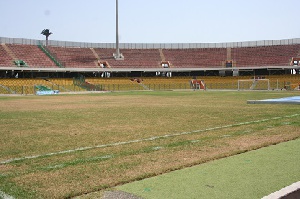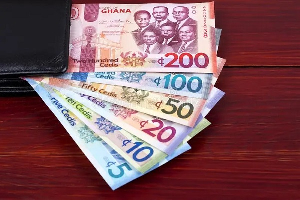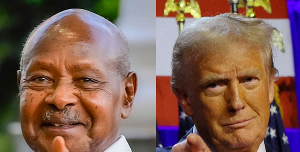History
Commissioned in 1960 to host football matches in the Greater Accra region, the famous Accra Sports Stadium, which is located between the former seat of the Government of Ghana and house of the legislature, the Christiansburg Castle, and Parliament House respectively, has gone through a lot in its five decades of existence.
It has been the centre of attraction for the fifty-four years, hosting not only super clashes between national club rivals, Accra Hearts of Oak and Kumasi Asante Kotoko, and also matches between West African rivals, Ghana and Nigeria.
The stadium, which had a capacity of 20,000, was renovated after Ghana received the bid to host the 26th edition of the African Cup of Nations (CAN 2008) into an edifice which met the standard to host FIFA matches.
The Government of Ghana reportedly spent close to GH¢30m on the project, which included the refurbishment of the state box, replacement of broken seats, re-grassing of the pitch, which was in a terrible state; replacement of broken and weak iron gates, provision of an ultra-modern scoreboard, provision of lawn mowers, sprinklers, water hoses and replacement of toilet facilities, as well as painting of the entire stadium.
After the project was completed, the Accra Sports Stadium was remarkably transformed. And the people of Accra had cause to beat their chest with pride once again.
The two famous city clubs of Accra Hearts of Oak and Great Olympics moved their home matches there with Dansoman-based Liberty Professionals also in Accra doing same when the Carl Reindolf Park, their base, was under rehabilitation.
The end of an era and beginning of corrosion
Unfortunately, the changes at the Accra Sports Stadium were short-lived. A recent visit by Today Sports to the stadium revealed a deteriorating state facility.
The picture painted during the visit suggested that little efforts have been made to maintain the once-celebrated sports facility commissioned to host the entire African continent in 2007.
The various sporting infrastructural facilities at the stadium were in very deplorable state with some not just requiring renovation but replacement if indeed the country was bent on bringing to its normal state, the famous Accra Sports Stadium, which has been a victim of political war between the New Patriotic Party (NPP) and the National Democratic Congress (NDC).
While the NPP changed its name to Ohene Djan Sports Stadium in honuor of Ghana’s first sports director, the NDC on assumption of power thought it was worthwhile to revert the name to Accra Sports Stadium to reflect the views and lineage of the Ga people on whose land the national edifice is sited.
As if by design, the deterioration of the facility commences from the entrance where the two iron gates and all other major iron gates which serve as entrance to vehicles entering the facility are fast corroding after being exposed to the weather for years. Even the metallic bars mounted at the various ticket gates are not spared of the corrosion, with their looks showing how bad they need painting.
It’s a goal
Unlike certain stadia in Germany and advanced countries which give room for spectators to stand and watch football matches, the Accra Sports Stadium offers a forty-thousand seating capacity. But, the once beautifully painted red, yellow, green and black seats have faded.
Most of the seats in the stands have broken down. Looking at the football pitch, which is nearly shorn of grass, it is hard to imagine that some of Africa’s and indeed, the world’s best football teams played matches on it.
The scoreboard is not working and the metallic pillars that hold it have also rusted.
There are also not enough dustbins at the stadium, so spectators litter refuse anywhere.
The turf is clearly in dire need of re-grassing, just as the entire stadium needs to be painted once again.
There is no or loose security at the stadium, as anyone at all could easily move from one stand to another and take pictures without any authorisation from any officials.
Confronted with this overwhelming evidence of neglect, one is compelled to wonder if the managers of the stadium have forgotten about the primary objective for which it was built in the first place.
In an interview with the Head of Public Relations at the National Sports Authority (NSA,) Mr. Hamah Hamid Issakah, he said his outfit need not to be blamed for the problems the stadium was going through, adding that the contractors are the cause of the problems.
According to him, it is very “unrealistic” how people who played integral part in the revamping of the Accra Sports Stadium in 2007, today, come out to condemn the National Sports Council (NSC) for the problems, stating that the sports authority made no impact in the renovation of the stadium as it was solely contracted and planned by the contractors who were in charge.
“It looks very funny when people who were involved in the construction of the stadium now condemn the authority because the sports authority’s input in the construction of the stadium was nil.”
Mr. Issakah indicated that having managed the stadium for some years ago, it would have been fair for the contractors to consult them before renovating it. He however added that they were all asked to move out of the stadium even before the renovation commenced.
“As people who have been managing the facility, we were supposed to be consulted so we can also express our views but that was not the situation as we were asked to leave the stadium because of the renovation exercise,” he said.
According to him, the entire stadium is dying as a result of the effects of the sea breeze.
“The sea breeze is killing the entire stadium and its facilities; the scoreboard has been seriously affected because it’s so exposed,” he indicated.
On the decay of the pitch, Mr. Issakah indicated that the movements of the presidency from the Castle to the Flagstaff House has also played a major role in the deterioration of the pitch as there is no consistent flow of water anymore.
“When the seat of government was at the Castle we had no problem because of the fact that our pipelines were connected from the Castle so everyday water was flowing… but ever since the seat of Government was moved to the Flagstaff House we have not been having regular flow of water,” he disclosed.
“…the only place where we could get water is around Adenta because they get their source from Kpong. Weija is salty, and if you apply water from Weija on the pitch for about one or two weeks you will kill the grass so we depend on Kpong,” he added.
He, however, said his outfit has decided to construct boreholes to curtail the issue of water shortage at the stadium.
Mr. Issakah further hinted that the stadium does not generate enough revenue from the league hence managing the facility was a major problem.
Fact Sheet
1960 – Commissioned
Capacity -40,000
1978 – Hosted AFCON final, Ghana won 2-0 against Uganda
2000 – Hosted the 2000 AFCON tournament which was co-hosted by Ghana and Nigeria
2001 – Accra Sports Stadium Disaster in which 127 soccer fans lost their lives
2004 – Named after Ghana’s first sports Director, Ohene Djan
2007 – Work on its rebuilding completed for AFCON 2008
2008 – Hosted the finals of the 26th edition of AFCON
April 2014 –Hosted the famous boxing match between Michael Aryittey and Braimah Kamoko
Sports News of Monday, 18 August 2014
Source: Today Newspaper













